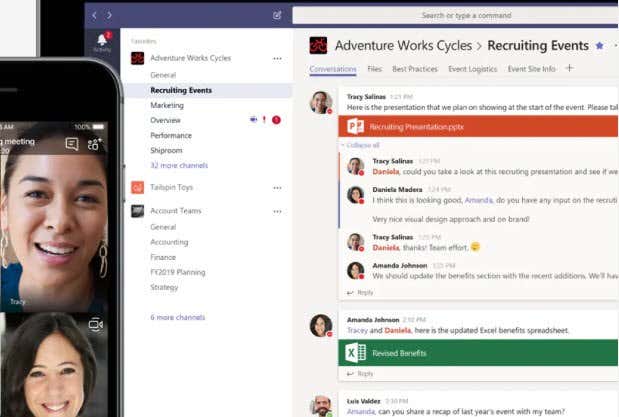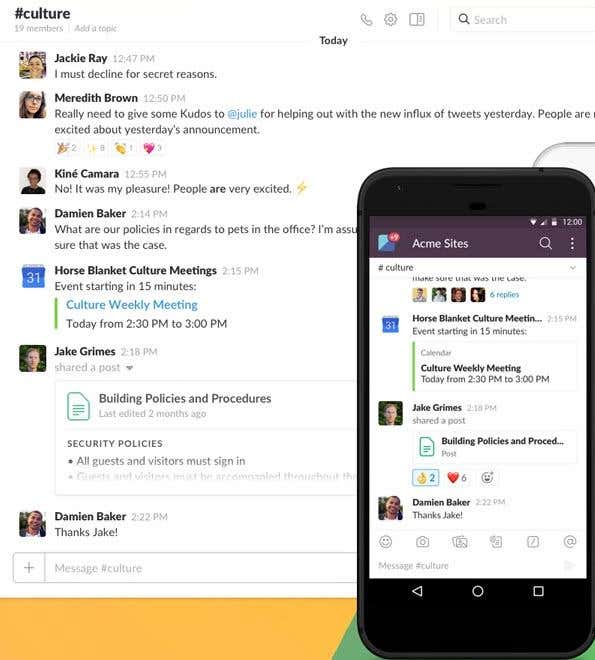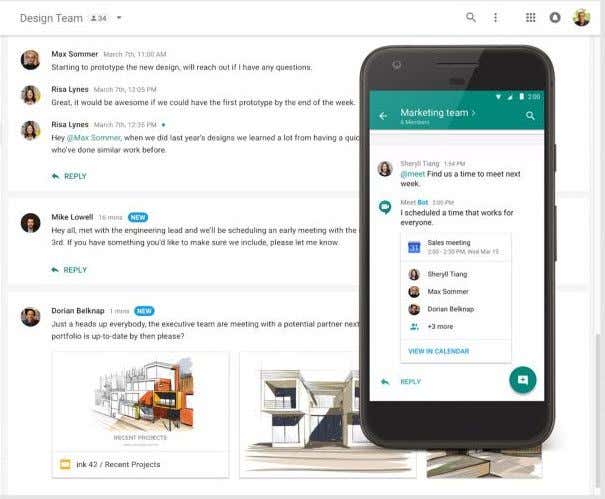There’s an abundance of free team chat software for Windows 10, but if you are working with a team, you’ll need to settle with just one. In this article, we take a look at the best options available and share why each option may be useful for you and your team based projects.
Keep in mind that all of the software mentioned in this article is generally considered by the public to be ‘good’ software, with the full range of file sharing, desktop/mobile and web based apps, chat logs, team conferencing, and collaboration features. We’ll be focusing on how each one differs from one another.

Microsoft Teams
Microsoft Teams is free, but with an Office 365 subscription you’ll get Office integration and more storage via OneDrive.

We’ll start with the first Windows-centric team chat software to bless Windows 10. Microsoft Teams has a lot of functionality available under its hood and thankfully it’s free to use. Here is a quick overview of what you get with the Microsoft Teams free version.
- Unlimited chat messages and search
- Video/audio calling for groups
- 10 GB team storage and 2 GB extra per person
- Integrated with Office Online
- More third party integrations include Evernote and Trello
- Add guests to chats when necessary
If your team is already invested into the Office ecosystem, Microsoft Teams will be the first best choice. It’s easy to set up a team for free and then share and edit documents right from within Microsoft Teams.
The Office 365 integration is easily where Microsoft Teams stands out, and it’s hard to find a more productivity-focused team software for Windows 10.
Another nice feature found in Microsoft Teams is the guest functionality. It becomes very easy to share limited time links to chats or video/voice calls to those outside of your team.
Guests get limited access and sharing capabilities. If needed, you can add individuals to your team at any point so that they can get access to all files and documents. Microsoft Teams has a standalone desktop app as well as a slimmer web based variant.
Slack
Slack is free, but plans from $8/month add unlimited message/file tracking and more.

If you have a project that has multiple tracks and prefer to keep everything up to date via text, Slack is the place for you. Slack has easily become one of the most popular free team chat options on the market. There are many reasons why Slack has seen such popularity. A quick overview has been provided below.
- Powerful shared file search (Search all messages and files)
- Conversations and topics organizable by channel
- Voice and video call also available on a channel by channel basis
- Extensive third party app support (From asana to zoom and everything in between)
- Powerful bots available for download or creation
One of my favorite features on Slack is the search system. When you have ongoing tasks within one project, it becomes very easy to lose important files or messages. With the search feature, you can track down anything within seconds. Slack is also geared up to be customizable to a way that suits you thanks to support bots and third party apps.
The Slack bots, in particular, take my interest. For example, bots like Diggbot and GrowthBot can help you to find trending content or topics. Or what about Eventbot Calendar?
With this, you can use text commands to easily set up meetings or reminders for dates. There’s plenty on offer, and if you can’t quite find what you’re after, dev tools are readily available for you to create your own bot.
Discord
Discord is entirely free – they have special features aimed at gamers for $9.99 a month, but no app functionality is restricted for free users.

Discord, in many ways, shares similarities with Slack. You have the same multi track channel support, and there are dozens of bots and app integrations available. Discord does have some differences, though. Let’s take a brief overview of these below.
- Support for ‘always on’ voice channels and text channels
- Easy to integrate bots and apps for more functionality
- Open channels to the public
- Create user groups and give different permissions based on group
Discord is better suited for more free-flowing conversation. You are able to create permanent voice channels where users can connect and disconnect to freely at any point. If you are the kind of team that likes to bounce off each other spontaneously as opposed to scheduling meetings at specific times, Discord voice channels would be perfect for that.
Engagement with your team members doesn’t stop at voice, though. You can set up text channels, too, and you are given an account where you can send private messages to other users.
Another thing I really like about Discord is its ability to make things public. It’s very easy to create channels for the public to access and then create channels that are only available for staff members. This particular setup could be useful for public facing teams that rely on the public’s feedback. For example, Discord is great for those looking for feedback from their users on a mobile app or an ever evolving video game.
Finally, Discord lets you assign each user with a ‘rank’ or place them into a certain group. You can then set permissions for each group. This is useful for when you need to give high level members of a project access to a room but don’t want others having access to it.
Google Hangouts Chat
Google Hangouts Chat costs $5 per user for 30GB storage, or $10 per user for unlimited storage. Alternatively, Classic Hangouts is available for free, but will be retired soon.

However, you must pay to integrate it all together into one standalone chat software app outside of Gmail called Google Hangouts Chat. If you want a core Google experience with more functionality, Google Hangouts Chat might be for you. Here are some key features.
- Virtual rooms to dedicate to different tasks
- Support for 8,000 members per room
- Easily upload and share any content from other Google apps
- Powerful search built straight into Hangouts Chat
- Compatible with the Hangouts app built into Gmail
Google Hangouts Chat further integrates all Google apps into one system. You can easily set up calendar reminders, create documents, Google spreadsheets, and set up Hangouts voice call meetings. It’s perfectly suited for those that are constantly checking in with their team via their phone, because you’ll have access to all Google suite apps through the app store.
I’m a little concerned about how often Google switches up their collaboration software, but regardless of whether Hangouts Chat stays or go, the core Google Drive and G Suite software is still a strong contender to other cloud based storage options.
Summary
Thanks for reading our guide to the best free team chat software for Windows 10. Have any questions about the software included in this article? If so, send me a tweet and I’ll get back to you soon. Enjoy!